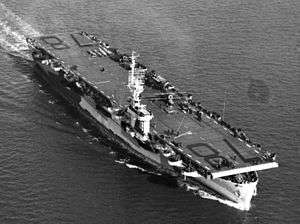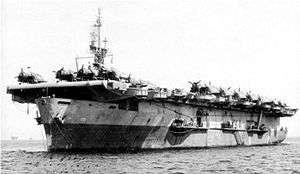USS Savo Island (CVE-78)
 USS Savo Island (CVE-78) underway in May 1944, location unknown. Note dismantled the SO3C Seamew, a J2F Duck (minus its engine), an SOC Seagull, and three F6F Hellcats lining the port side, with spare floats lashed down aft. | |
| History | |
|---|---|
| Name: | USS Savo Island |
| Builder: | Kaiser Shipyards |
| Laid down: | 27 September 1943 |
| Launched: | 22 December 1943 |
| Commissioned: | 3 February 1944 |
| Decommissioned: | 12 December 1946 |
| Struck: | 1 September 1959 |
| Fate: | Sold for scrap on 29 February 1960 |
| General characteristics | |
| Class and type: | Casablanca-class escort carrier |
| Displacement: | 7,800 tons (standard), 9,750 tons (full load) |
| Length: | 512 ft 3 in (156.13 m) overall |
| Beam: | 65 ft 2 in (19.86 m), 108 ft 1 in (32.94 m) maximum width |
| Draft: | 22 ft 6 in (6.86 m) |
| Propulsion: |
|
| Speed: | 19.3 knots (35.7 km/h) |
| Range: | 10,240 nmi (18,960 km) at 15 kn (28 km/h) |
| Complement: |
|
| Armament: | 1 × 5 in (127 mm)/38 cal dual purpose gun, 16 × Bofors 40 mm guns (8×2), 20 × Oerlikon 20 mm cannons (20×1) |
| Aircraft carried: | 28 |
| Service record | |
| Part of: | United States Pacific Fleet (1944-1946), Atlantic Reserve Fleet (1946-1959) |
| Operations: | Mariana and Palau Islands campaign, Battle off Samar, Philippines campaign, Battle of Okinawa, Operation Magic Carpet |
| Awards: | Presidential Unit Citation, 4 Battle stars |
USS Savo Island (CVE-78), was a Casablanca-class escort carrier built for the United States Navy during World War II. Named in memory of a naval battle fought off Savo Island in the Solomons on 9 August 1942, she was the only U.S. Naval vessel to bear the name.
Originally designated Kaita Bay (AVG-78), she was reclassified ACV-78 on 20 August 1942 and CVE-78 on 15 July 1943; laid down under Maritime Commission contract (MC hull 1115) on 27 September 1943 by Kaiser Shipbuilding Co., Vancouver, Washington; renamed Savo Island on 6 November 1943; launched on 22 December 1943; sponsored by Miss Margaret Taffinder; and commissioned on 3 February 1944, Captain C. E. Eckstrom in command.
Service history
After shakedown at San Diego, Savo Island made two voyages to the Southwest Pacific carrying replacement aircraft from 15 March-2 July 1944. On 6 July, her air squadron reported on board; and, after training at San Diego and Pearl Harbor, she reported to the 3rd Fleet at Pearl Harbor on 4 August. Savo Island's first combat assignment was to provide air support for the landings on Peleliu Island in the Palaus. Between 11 September and 30 September, she operated with a group of escort carriers near the island, while her planes conducted pre-invasion strafing, direct support of ground forces and patrol missions. On 3 October, she reported to the 7th Fleet at Manus Island, and sailed on the 12th in the screen of the bombardment and support group of battleships and cruisers of the Leyte invasion task force. Upon arriving on the 18th, her aircraft carried out patrols and strikes against predesignated targets, and shifted to ground support missions as the troops went ashore on the 20th. Her planes remained at the task for the next few days.
On the morning of the 25th, an escort carrier force off Samar, "Taffy 3", some 20 miles to the north, reported a large enemy surface force. This turned out to be the central force in a three-pronged, Japanese naval assault on Allied forces at Leyte, consisting of four battleships, six cruisers, and many destroyers. The escorts of Savo Island's group also came under fire for about 30 minutes, as the carrier launched a total of six strikes in a desperate and successful effort to protect herself and the other carriers from annihilation. The Japanese retired in the face of the intense air opposition, losing three cruisers in the engagement. During the afternoon, the American forces again came under fierce air attack, experiencing the first suicide attacks of the war. Savo Island remained off Leyte until 30 October, when she sailed for the Admiralties. Savo Island departed Manus on 19 November, and from 22–27 November, served with two other escort carriers as a patrol and escort force in the convoy lanes leading to Leyte Gulf. After replenishing in Kossol Passage in the Palaus, she got underway on 10 December for her third amphibious operation, the landings on Mindanao. Once again, she covered the bombardment group during the approach and then provided direct support over the beaches until relieved by Army aircraft on 15 December. Threat of a Japanese surface raid delayed her departure until 17 December, when she sailed for Manus.
Savo Island performed similar duties during the Lingayen Gulf operation commencing on 1 January 1945. During the approach, Ommaney Bay, was sunk by a kamikaze on the 4th and another grazed Savo Island the next day. After the Lingayen landings, Savo Island's group steamed to the westward of Mindanao from 17–29 January, as a defense against enemy surface attack. After supporting landings near Subic Bay on the 29th-30th, she retired to Ulithi for repairs and replacement of her air group. After repairs and training exercises for her new pilots, Savo Island departed Leyte with the invasion force for Okinawa, providing air cover en route. On 26 March, with two other escort carriers, she supported the occupation of Kerama Retto, which was to become the main replenishment base for the naval forces off Okinawa. The following day, her planes joined the assault on Okinawa, and flew antiaircraft and antisubmarine patrols as well. From 7–16 April, she provided air cover for the replenishment group steaming to the east of Okinawa. She then resumed her support mission off Okinawa, and on 27 April carried out neutralizing strikes against Sakishima Gunto, halfway between Okinawa and Formosa. On 29 April, the carrier completed her mission and sailed for overhaul in San Diego.

On 11 July, Savo Island began a ferry voyage from San Diego to Pearl Harbor and back to Alameda, California On 6 August, she sailed for the Aleutians and arrived on the day of the Japanese surrender. She departed on 31 August with a force of six escort carriers to support the occupation of northern Honshū and Hokkaidō. The ship returned to Pearl Harbor on 25 September 1945, and was assigned to "Magic Carpet" duty. After picking up occupation troops at San Francisco, she made three voyages carrying troops home, one each from Guam, Pearl Harbor, and Okinawa. Released from "Magic Carpet" duty upon arrival at Seattle on 14 January 1946, she arrived at Boston, Massachusetts on 16 March for inactivation. The carrier was decommissioned on 12 December 1946 and assigned to the Boston group of the Atlantic Reserve Fleet. Savo Island was reclassified CVHE-78 on 12 June 1955 and AKV-28 on 7 May 1959. She was struck from the Naval Vessel Register on 1 September 1959; sold on 29 February 1960 to Comarket, Inc.; and broken up for scrap in Hong Kong in June, 1960.
Awards
Savo Island received 4 battle stars for her World War II service. In addition, she received a Presidential Unit Citation for her service in the Western Carolines, the Philippines, and Okinawa from 6 September 1944 – 29 April 1945.
In popular culture
While the Savo Island spent the Korean War in mothballs as part of the Atlantic Reserve Fleet, author James Michener fictionally had it in commission (as an Essex-class fleet carrier) and participating in that war as the primary setting for his novella The Bridges at Toko-Ri. The 1954 movie version was filmed aboard the USS Oriskany (CV-34) with its original CV-34 markings, but the ship was still referred to as the Savo Island.
References
This article incorporates text from the public domain Dictionary of American Naval Fighting Ships.
- "Savo Island". Dictionary of American Naval Fighting Ships. Retrieved 5 July 2007.
- "USS Savo Island (CVE-78) (later CVHE-78 and AKV-28)". Escort Carrier Photo Archive. Retrieved 5 July 2007.